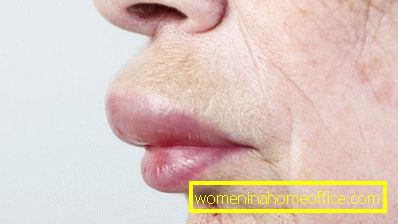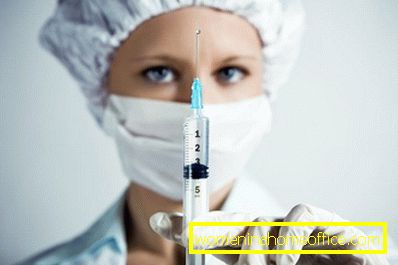Quincke’s edema
People suffering from hypersensitivity to any substances know how painful the body reacts to stimuli. An allergic reaction can be how severe that Quincke edema begins. Symptoms of this disease are signals that immediate treatment is required, otherwise it will not be possible to avoid the sad consequences.
In connection with the increase in the number of patients diagnosed with allergies or congenital disorders in the work of the complementary system (component of immunity), cases of angioedema are becoming more frequent. Puffiness of different parts of the body not only causes inconvenience to a person, but also represents a danger to life.
"Two-faced" Quincke

Angioedema is a pathology in which the mucous epithelium, skin and subcutaneous tissue in the neck, face, feet, hands and sternum swells. In some cases, the meninges, internal organs and joints increase in size. Causes of angioedema are rooted in external factors or failures in the work of the body's defenses.
There are two forms of this pathology:
- allergic;
- pseudoallergic.
An allergic form of the disease develops as a result of contact with a specific allergen - medicine, food, plant pollen, etc. The edema of the second type is often observed with such congenital dysfunction as spontaneous activation of complex proteins involved in the functioning of the immune system. The manifestation of violations provoke:
- sharp change in air temperature;
- nerve strain;
- stressful condition;
- injury.
How to detect danger?
The first sign of an insidious disease is the rapid swelling of the mucous membranes and skin in a certain place. Its color does not change, itching is absent, but there is a burning sensation and soreness. Large edemas usually appear in the area:
- lips and mouth;
- nose, eye lids and cheeks;
- genital mucosa.
At the time of formation of such seals, the patient may complain of tension and an increase in the tongue, tonsils, palate. If the process affects the larynx:
- the patient is hard to swallow;
- voice becomes hoarse;
- breathing is difficult;
- attacks of rough cough begin;
- face first blush, and then abruptly pales.
Edema of the digestive system is accompanied by:
- vomiting;
- rumbling in the stomach;
- pain in the peritoneum;
- nausea;
- persistent diarrhea.
With the defeat of the urinary tract, the following disorders are possible:

- frequent and difficult urination;
- pain and pain during emptying the bladder;
- constant desire to urinate.
In rare cases, the brain swells. The clinical picture of this condition is very similar to the signs of other diseases of the central nervous system:
- drowsiness;
- slow reactions;
- nausea;
- in the supine position it is impossible to touch the breast with the chin;
- sometimes convulsions and coma.
Symptoms and treatment of angioedema in children have some peculiarities. The process most often extends to the face, genitals, upper and lower extremities, organs of the gastrointestinal tract and the larynx. When the internal organs are swollen, the skin of the child can maintain a normal appearance. Throat and bronchus swelling is most dangerous: there are problems with speech, swallowing, breathing, possibly hemoptysis. Without emergency intervention of physicians, the baby may die. No less disturbing are the signs of a pathological process in the children's brain:
- seizures like epilepsy;
- visual impairment;
- paralysis;
- speech defects;
- dizziness;
- increase muscle tone of the neck.
In the hospital, after confirming the presence of symptoms characteristic of angioedema, the diagnosis will be confirmed by:
- complement system studies;
- determining the level of immunoglobulin E;
- allergosorbent multiple test.
To do this, you will need to donate blood from a vein. After 2-3 months, skin samples will be taken for exposure to stimuli and the main indicators of the immune system will be tested according to the results of the analysis of biological fluids.
Weapons against insidious swelling

If a person has signs of allergic or pseudo-allergic edema, do not hesitate:
- discontinue contact with irritant;
- remove from it the pressing parts of clothes;
- create the most relaxed atmosphere;
- air the room;
- put ice on the inflamed place;
- offer drinking in large quantities.
In case of suspicious puffiness after a human has been stung by an insect or an injection has been made:
- put a cotton swab dipped in cold water into the puncture site;
- lay a rope a few centimeters above the hole;
- apply vasoconstrictor nasal drops and a means of blocking the accumulation of histamine in the body, for example, Tavegil.
First aid for angioedema is provided before the arrival of ambulance doctors. Arrived doctors:
- make an injection of the hormone Prednisolone or Dexazone;
- suprastin is administered intramuscularly;
- will give to drink an enterosorbent and a diuretic;
- block the breakdown of proteins with kontrikala or epsilon-aminocaproic acid.
In case of suffocation due to edema of the larynx, an urgent tracheotomy is shown - dissection of the anterior wall of the trachea with the subsequent insertion of a tube into its lumen or the creation of a permanent opening. After urgent actions to alleviate the patient's symptoms, they are hospitalized to the allergology department for further treatment of Quincke edema with the help of:
- antihistamine drugs - Dimedrol, Claritina;
- systemic corticosteroids - Dexametozone, hydrocortisone;
- diuretic - Furosemide, Diakarba.
Also, for the normalization of the nervous system need vitamin C and ephedrine. An important step, especially during the treatment of children, is the elimination of chronic diseases and purification from parasites. The actions of physicians will be useless if you do not avoid the entry of potential irritants into the body. For a short time, a herbal milk salt-free diet is recommended.
We will not allow the repetition of trouble

People who have had Quincke’s edema should have a syringe and vial of adrenaline in their home and travel kits. To not give such an injection:
- prevent contact with allergenic substances;
- refuse the use of alcoholic beverages;
- avoid hypothermia, overheating, and stress.
Anyone who has previously been diagnosed with angioedema, experts advised to exclude from the diet such berries, vegetables and fruits:
- raspberries, strawberries and strawberries;
- apricots, cherries, plums, peaches;
- apples and grapes;
- potatoes, tomatoes and cucumbers;
Medicines may also cause harm:
- Aspirin;
- Askofen;
- Analgin;
- Paracetamol;
- Ibuprofen;
- Baralgin;
- Citramon;
- Pentalgin;
- Butadion and others
Persons with hereditary failures in the activation of proteins should, if possible, avoid surgical interventions and injuries.
Unexpected swelling of certain parts of the body can be the result of an allergic reaction complicated by Quincke edema. If you call the doctors in time and give first aid correctly, the swelling will disappear within 24 hours. So that the threat to life does not happen again, you need to undergo a course of treatment and strictly implement preventive measures. A negative reaction of the body to an allergen is not a reason to get upset, but a call to act!